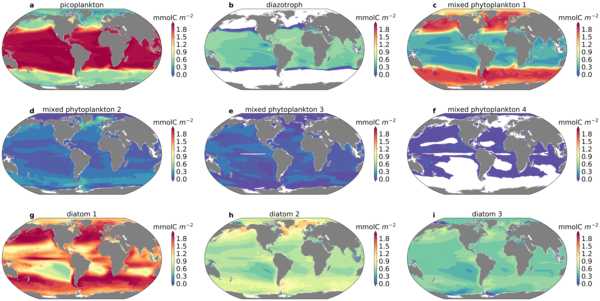Data from: Plankton energy flows using a global size-structured and trait-based model
Data from: Plankton energy flows using a global size-structured and trait-based model
About this collection
- Extent
-
1 digital object.
- Cite This Work
-
Negrete-García, Gabriela; Luo, Jessica Y.; Long, Matthew C.; Lindsay, Keith; Levy, Michael; Barton, Andrew D. (2022). Data from: Plankton energy flows using a global size-structured and trait-based model. UC San Diego Library Digital Collections. https://doi.org/10.6075/J0NK3F6D
- Description
-
Abstract: Plankton community models are critical tools for understanding the processes that shape marine plankton communities, how plankton communities impact biogeochemical cycles, and the feedbacks between community structure and function. Here, using the flexible Marine Biogeochemistry Library (MARBL), we present the Size-based Plankton Ecological TRAits (MARBL-SPECTRA) model, which is designed to represent a diverse plankton community while remaining computationally tractable. MARBL-SPECTRA is composed of nine phytoplankton and six zooplankton size classes represented using allometric scaling relationships for physiological traits and interactions within multiple functional types. MARBL-SPECTRA is embedded within the global ocean component of the Community Earth System Model (CESM) and simulates large-scale, emergent patterns in phytoplankton growth limitation, plankton phenology, plankton generation time, and trophic transfer efficiency. The model qualitatively reproduces observed global patterns of surface nutrients, chlorophyll biomass, net primary production, and the biogeographies of a range of plankton size classes. In addition, the model simulates how predator:prey dynamics and trophic efficiency vary across gradients in total ecosystem productivity. Shorter food chains that export proportionally more carbon from the surface to the ocean interior occur in productive regions, whereas in oligotrophic regions, the food chains are relatively long and export less organic matter from the surface. The union of functional type modeling with size-resolved, trait-based modeling approaches allows MARBL-SPECTRA to capture both the large-scale elemental cycles and the structure of planktonic food webs affecting trophic transfer efficiency.
MARBL-SPECTRA simulations are forced with the Common Ocean-Ice Reference Experiment (CORE-II) data set (Large et al. 2009). The forcing period from 1948 to 2009 (62 years) underwent two repeating cycles, however, we focused our analyses on the final 20 years of the simulation (1990-2009). MARBL-SPECTRA has been implemented in the Parallel Ocean Program version 2 (POP2; the CESM2 ocean component). The output includes monthly diagnostic and prognostic variables with nominal horizontal resolution of 1 degree, with 60 vertical depth levels ranging in thickness from 10 m in the upper 150m to 250 m in the deep ocean. For more information on the setup, processing, and analysis, please refer to Negrete García et al. 2022 (DOI to be determined later). - Creation Date
- 1990 to 2009
- Date Issued
- 2022
- Authors
- Funding
-
This output is based upon work supported by the National Center for Atmospheric Research, which is a major facility sponsored by the National Science Foundation under Cooperative Agreement No. 1852977, and the National Science Foundation Graduate Research Fellowship under Grant No. (DGE-2038238 and DGE-1650112).
In addition to NSF funds to NCAR, MARBL development has been supported by the Office of Biological & Environmental Research (BER) within the Department of Energy (DOE) (DE-SC0012603). - Geographic
- Topics
Formats
View formats within this collection
- Language
- English
- Identifier
-
Identifier: Andrew D. Barton: https://orcid.org/0000-0002-6480-4433
Identifier: Gabriela Negrete-García: https://orcid.org/0000-0002-9301-8239
Identifier: Jessica Y. Luo: https://orcid.org/0000-0002-0032-9370
Identifier: Keith Lindsay: https://orcid.org/0000-0002-3672-1665
Identifier: Matthew C. Long: https://orcid.org/0000-0003-1273-2957
Identifier: Michael Levy: https://orcid.org/0000-0001-6553-2153
- Related Resources
- Gabriela Negrete-García, Jessica Y. Luo, Matthew C. Long, Keith Lindsay, Michael Levy, Andrew D. Barton (2022). Plankton energy flows using a global size-structured and trait-based model. Progress in Oceanography, Volume 209, 102898. https://doi.org/10.1016/j.pocean.2022.102898
- GitHub repository for the version of MARBL used for these simulations: https://github.com/marbl-ecosys/MARBL
- GitHub repository of code for generating the namelist parameters for MARBL-SPECTRA: https://github.com/jessluo/gen_spectra
- Long, Matthew C., J. Keith Moore, Keith Lindsay, Michael Levy, Scott C. Doney, Jessica Y. Luo, Kristen M. Krumhardt, Robert T. Letscher, Grover Maxwell, and Zephyr T. Sylvester. "Simulations with the Marine Biogeochemistry Library (MARBL)." Journal of Advances in Modeling Earth Systems 13, no. 12 (2021). https://doi.org/10.1029/2021MS002647
Primary associated publication
Software
Reference
 Library Digital Collections
Library Digital Collections
